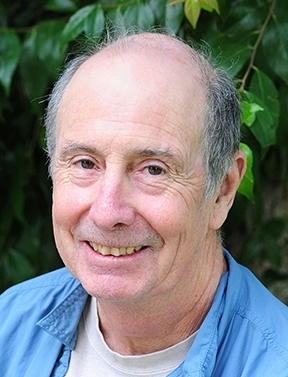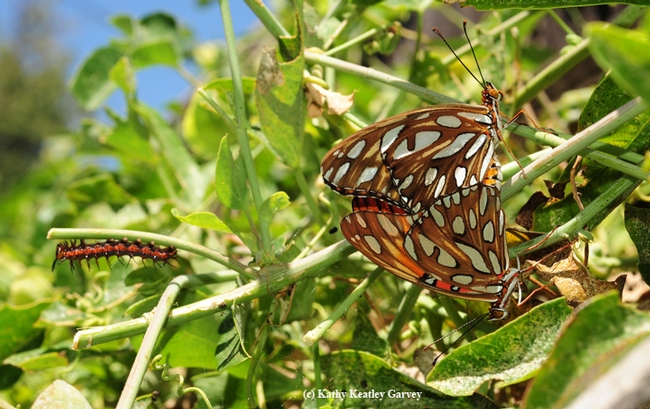
Bruce Hammock, UC Davis distinguished professor of entomology who holds a joint appointment with the UC Davis Comprehensive Cancer Center, is fond of saying that in his many talks.
"Science is full of surprises."
His research clearly shows that basic science can lead to surprising findings.
A recently published news story, "From Caterpillars to Kidney Disease: Surprise Discoveries in Basic Science," on the Medical College of Wisconsin website chronicles how Hammock's basic research on caterpillars--how caterpillars become butterflies--led to key discoveries about chronic pain, including diabetic pain.
As an aside, Hammock suggested to communication specialist Karri Stock that the story could include a photo of a caterpillar and a butterfly, and did I have one?
I did, thanks to the Gulf Fritillary (Agraulis vanillae) population explosion on our passionflower vine (Passiflora). A caterpillar was doing what caterpillars do. Then two butterflies came along and started doing what males and females do. The three-in-one photo illustrates the article, along with a photo of Hammock and collaborator John Imig, professor of pharmacology and toxicology at the Medical College of Wisconsin, Milwaukee.
The gist of the news story is that Imig received a $2.3 million grant from the National Institute of Diabetes and Digestive and Kidney Diseases "to investigate the development of a drug to treat type 2 diabetes and metabolic syndrome."
"But what we didn't tell you is that this translational grant is all thanks to some caterpillars in California and decades of research," Stock wrote. "It's a tale of pure curiosity with a great lesson for budding scientists and the public alike: You can't always predict where basic science discoveries will lead."
She related how, more than 40 years ago, a young entomologist in California named Bruce Hammock found a key enzyme (epoxide hydrolase or EH) in the metamorphosis of caterpillars into butterflies. "The enzyme degrades a caterpillar's juvenile hormone, allowing it to move from the larval stage into an adult insect. Early in his career, Dr. Hammock found that if he exploited this EH and prevented larvae from becoming adults, he had on his hands an effective genetically engineered insecticide."
Then came the basic science and fundamental questions that Hammock asked. "Does the enzyme occur in plants? Does it occur in mammals?"
"And it turns out that it does, particularly as soluble epoxide hydrolase (sEH) in mammals, including mice and humans, and its distribution suggested it was involved in regulatory biology," Stock wrote. She went on to detail the collaboration of Hammock and Imig. Read the entire MCW story here.
Hammock's work has drawn national and international attention. Groundbreaking neuropathic pain research emanating from the Hammock lab made Discover magazine's Top 100 Science Stories of 2015 ranking among the Top 15 in the medicine/genetics category.
The UC Davis research was singled out for its “Endoplasmic Reticulum Stress in the Peripheral Nervous System is a Significant Driver of Neuropathic Pain,” published in July 2015 in the Proceedings of the National Academy of Sciences. (See UC Davis news story).
Highly honored by his peers, Hammock is a fellow of the National Academy of Inventors, which honors academic invention and encourages translations of inventions to benefit society. He is a member of the U.S. National Academy of Sciences, a fellow of the Entomological Society of America, and the recipient of the Bernard B. Brodie Award in Drug Metabolism, sponsored by the America Society for Pharmacology and Experimental Therapeutics. He directs the campuswide Superfund Research Program, National Institutes of Health Biotechnology Training Program, and the National Institute of Environmental Health Sciences (NIEHS) Combined Analytical Laboratory.
A native of Little Rock, Ark., Bruce earned a bachelor's degree in entomology from Louisiana State University in 1969 and his doctorate in entomology/toxicology from UC Berkeley in 1973, and then accepted a Rockefeller Postdoctoral Fellowship at Northwestern University. Hammock served as a member of the UC Riverside faculty for six years before joining UC Davis in 1980. In addition to maintaining a vigorous research program, Hammock teaches, mentors students, works with visiting scholars and enjoys rock climbing and kayaking.
And if you get a chance to hear him speak about his research, he's likely to say: "Science is full of surprises."
Because it is.
Attached Images:
